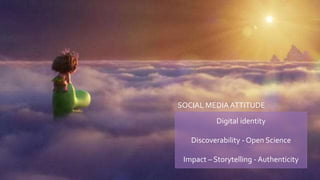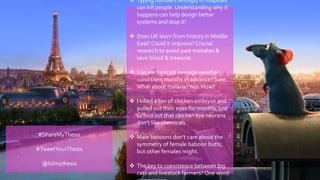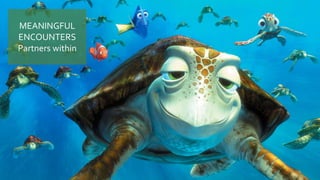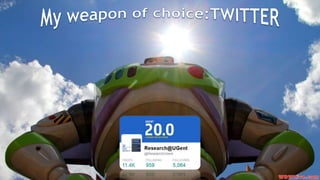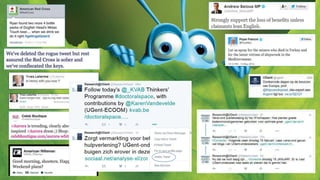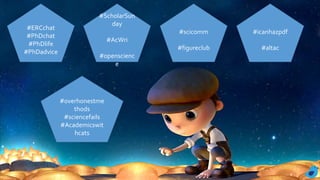Twitter voor onderzoekers
- 3. Digital identity Discoverability - Open Science Impact – Storytelling - Authenticity SOCIAL MEDIA ATTITUDE
- 5. Goodier and Czerniewicz, http://openuct.uct.ac.za/sites/default/files/Online%20Visibility%2 0Guidelines.pdf Assess yourself Decide on your profile Availability of your outputs Communicate & interact Digital identity
- 6. Digital identity Discoverability - Open Science Impact – Storytelling - Authenticity SOCIAL MEDIA ATTITUDE
- 7. Science is based on building on, reusing and openly criticising the body of scientific knowledge. Panton Principles OPEN SCIENCE
- 8. Digital identity Discoverability - Open Science Impact – Storytelling - Authenticity SOCIAL MEDIA ATTITUDE
- 9. What might be the impact of your research? How to communicate with impact?
- 11. #ShareMyThesis #TweetYourThesis @lolmythesis Typing numbers wrongly in hospitals can kill people. Understanding why it happens can help design better systems and stop it! Does UK learn from history in Middle East? Could it improve? Crucial research to avoid past mistakes & save blood & treasure. Can we forecast average weather conditions months in advance? Sure. What about malaria?Yep. How? I killed a ton of chicken embryos and pulled out their eyes for months, just to find out that chicken eye neurons don’t like chemicals. Male baboons don't care about the symmetry of female baboon butts, but other females might. The key to coexistence between big cats and livestock farmers? One word:
- 12. Pixar says: Why must you tell this story? story? What’s the belief burning within within you that your story feeds feeds off of? That’s the heart of it. AUTHENTICIT Y
- 13. PEOPLE TOOLS ONCEYOU’VE GOTTHE ATTITUDE,YOU’RE READY FORTHE NEXT STEP
- 17. TOOLS
- 18. • Self-promotion • Time pressures/procrastination • Exposure of person/ideas • Plagiarism/commercialisatio n • Obligation • Institutional rules Status anxiety Accelerated academy Open science CHALLENGES
- 19. IS IT WORT H IT? (old style) Highly tweeted articles were 11 times more likely to be highly cited. (Eysenbach 2011) Blog posts about recent articles help boost citations but is looks like a correlation, not causation. But there are a lot of science blogs… Social media promotion doesn’t have a significant effect on article download rates when your readers aren’t on social media. Factors driving social media and citations are different. Social media can not be seen as an alternative to citations. (Haustein 2015)
- 20. What do you want to achieve by engaging with social media? What is your communication/outreach strategy? Consider producing social media content as a normal part of your (working) life Develop a sense of the advantages and limitations of each different platform Be realistic about the time available to you. Know who can help you. Be aware of your digital footprint. Invest in visibility. Re-use content but adapt.Get your timing and story right. Have fun! RECAP - MAKE IT
- 22. Generate/refine ideas Hone writing skills Discover/share resources Professional development Career opportunities Media/public engagement Create involvement Conference back- SOCIAL TWITTE R
- 23. Let’s Talk about Twitter, Kerry Ann Rockquemore, Inside Higher Ed (20 May 2015)
- 24. Online collaboration: Scientists and the social network, Richard Van Noorden, Nature 512, 126– 129 (14 August 2014)
- 25. BIO + PICTURES SETTINGS FOLLOW LISTEN TWEET ENGAGE MONITOR GETYOUR HANDLE OUT THERE
- 29. VISUALS DRIVE ENGAGEMENT USING LISTS RETWEET – MENTION – REPLY – DIRECT MESSAGE ILLUSIVETIMING
- 30. try to stick to it Management of expectations: bio & content/activity to match Tweet ‘thickly’ and according to the rules Build a network and include influencers Social medium = interact Authenticity, niceness, integrity, and common sense
- 32. Esther De Smet Research Department Ghent University @sterretje8 Thank you for participating!
Editor's Notes
- * TWEET * What do you want to share at this point? Why are you in this workshop?
- There are two broad categories of online content to consider when talking about your online presence digital footprint is your active contribution to and interaction with the online world digital shadow is content about you posted and uploaded by others, as well as automatically generated and collated content You should try and maximise the former and watch the latter, especially as it is difficult to control. The best way to drown out content about yourself that you may not like is to upload content of your choice.
- How do you want to come across? How much time do you have? Assess what publications and other outputs of yours are already online and then sharing everything else you are able to, including teaching resources and ‘popular or informal’ resources in a variety of formats. Start communicating and interacting.
- Cf. previous slide Remember: not just accessibility within academic context!
- Open science is not just technology, it’s a state of mind. Sharing is caring. * TWEET * Why do you care about open science?
- * TWEET * what’s the potential impact of your research?
- * TWEET * Use a storytelling device to tweet something about your research
- EXAMPLES #sharemythesis: competition by British Library LOL my thesis: tumblr
- Look for partners and experts within your organization. You do not need to do everything yourself. Multiplier effect!
- Who are the beneficiaries of your research? Knowing about the potential impact of your research, helps to answer this question. Negative impact?
- Who needs to be part of your network? Who might amplify your message? Who do you admire? * EXERCISE * find a twitter account (using users and keywords)
- There are many online tools available for disseminating your research and/or for interacting about science. The important thing is choosing the right tool for your specific goal. And then making it your own and giving it a natural place in your work and life so it does not feel like a chore.
- * TWEET * What holds you back? Status anxiety: should academics be using social media? D. Lupton Reaching out. Nature blog by Soapbox Science (7 June 2012) It is a nuanced story. Not everyone is a fan or naturally gifted or even at ease when participating in science engagement and/or social media. There might even be criticism of peers or mentors. Institutional rewards and incentives are lacking. Not everyone’s research is applied or sexy. There is also a worry that we might be evolving towards more of the same: Academic attention economy (cf. Kardashian Index) *** Why are not doing it? Why are you doing it? ***
- Altmetrics “Among social media metrics, citations correlate the most with Twitter, although tweets are not a good predictor of citation impact.”
- Although it is a big investment and there are some definite challenges, there are great benefits to integrating social media into your research – not just as a way to communicate but also as a means to become a better scholar. Social media offers you the means to interact directly with a broader audience – often without ‘corporate interference’. Although it can be great fun and many of the social media look flighty (eg. half-life of a tweet is 18 minutes) it should not be taken lightly but approached in a strategic and professional manner. It’s all about finding the right balance: Not overthinking it but using it to your advantage Getting into the spirit of sharing and interacting while keeping focus in your own research and not losing yourself in procrastination Giving it a natural place in your time management and approaching it so you feel comfortable with it * TWEET – what has made an impression on you so far?
- Twitter is an easy but worthwhile tool to start engaging about your research. These are some of the benefits: Connect with peers and building a scholarly network. Quote: “It’s allowed me to open up new communities for discussions and increase the interdisciplinarity of my research.” (A network boost by M. Baker. Nature, 12 Feb 2015) Sharing and finding resources (think ‘open science’) Generating and refining ideas Honing writing skills: try building up a lucid argument in 140 characters! Reputation management (part of larger strategy in managing your digital footprint/shadow) Dissemination of your research. Don’t just tweet your new scientific articles but try to capture the attention of more people by making the content accessible. Public engagement and creating involvement: why not look for participants this way? And remember, there’s a lot of journalists and media outlets on there too… Jobs & prof. development: “Following institutions, companies and individuals on Twitter can offer clues about workplace culture and ongoing projects in a way that static website do not.” “Junior researchers are creating identities that don’t have to be routed through the principal investigator.” (A network boost by M. Baker. Nature, 12 Feb 2015) It is a great tool for conferences: Back-channel: capture content & provide feedback, share questions and resources Connecting and networking Virtual participation There is of course a big social element to it (especially for ECRs): Break isolation Look over the fence Find fellow victims Real-life scholar Sheer fun of it
- Settings: more is good at the start Follow: Twitter etiquette does not require that you follow someone just because they follow you, but following someone is a way of indicating your presence to them. Tweet: mixture of about 30% chatter and 70% content is seen as a golden standard. Doesn’t have to be all original Engage: follow up! Monitor: twitter analytics
- * Question for audience: what went wrong? *
- Hashtags mean more engagement Keep your hashtag short, or long and catchy – but not too long! Use recognisable words and phrases known to your community or target audience, and always check that your hashtag isn’t being used by others don’t use too many hashtags in a single tweet * TWEET * try one!
- David Silver - thin tweets are posts that convey one layer of information. thick tweets convey two or more, often with help from a hyperlink, visual and/or mention.



